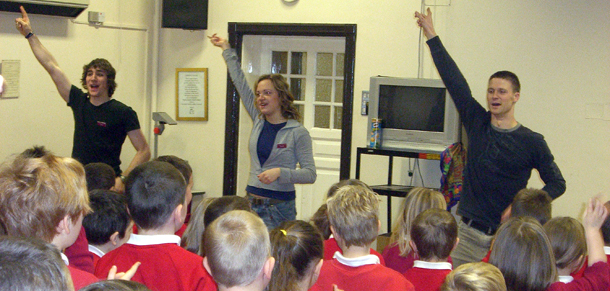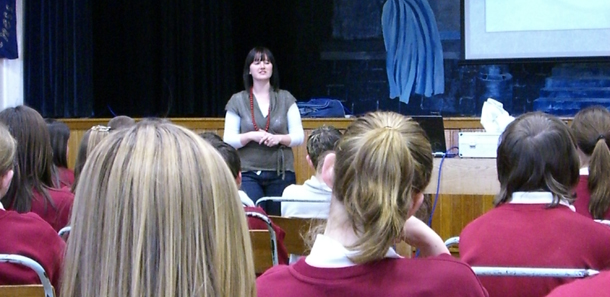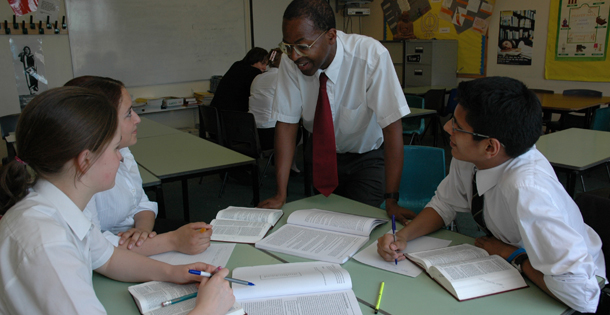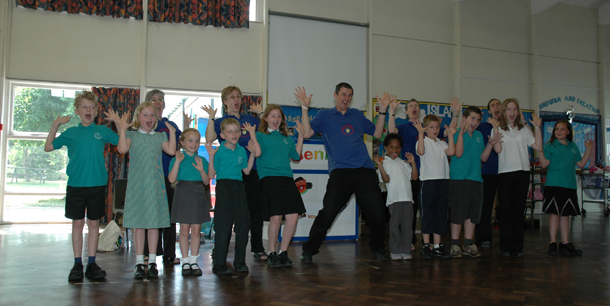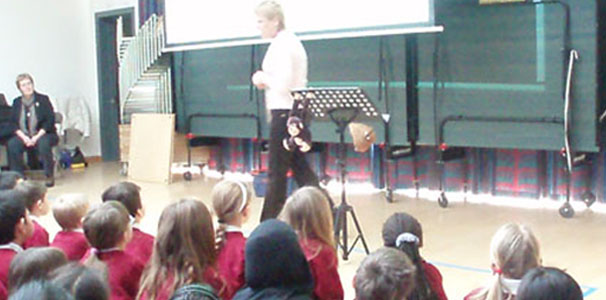Secondary School Assemblies
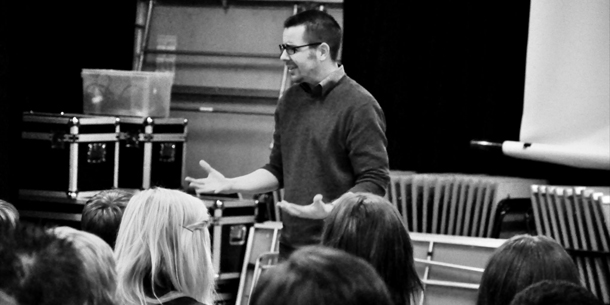
So, Monday morning has arrived after a wet & cold half-term break, and the assembly is waiting at a school half an hour away. Of course, you’re well prepared, having established what is to be presented and what materials are going to be used. And having cemented the outline into your head, you’re now rehearsing how it will go on the journey to the school. Of course, you’ll need to allow for the many eruptions of belly-laughter from the 200 Year 11 students who are going to be truly blessed by your phenomenal wit in just a short time….
Once signed in, you make your way to the hall to discover that exams are underway and the hall is out of action. But they’re delighted to announce they have a backup location for you in the large common area where several classrooms meet. It will seat 200 easily…if they’re 4 years old! On entering the common room, your obvious delight at the room change is magnified further by discovering there is no projector, no screen – in fact, no plug sockets! Plan ‘B’ will have to come into action – but you’re prepared for that too…aren’t you?
With seconds to go, the head of year 11 enters and gives you a double-take that any Oscar nominee would be proud of and says “Is it today you’re coming in?”. You decide not to reply as you feel your presence is a sufficient answer.
So, you’re in and ready for Plan ‘B’ assembly as the Year 11 students make their way to the common area. You can sense their delight at how soon Monday morning has arrived by their slowly-than-snail-pace to get into the area. Their pace is further reduced by the wonderful news that they won’t be sat on chairs this morning either…the girls particularly love this revelation.
Still, you are here as their Monday morning superhero…here to save them from an otherwise dull beginning to the week. But just before your shining moment, the HoY announces they “just want to make a quick announcement before handing over to you”. And then it comes. The biggest rollicking you have experienced since Delia Smith’s motivational half-time rouser to Norwich City in 2005. As the Year 11s discover that all lunchtime privileges have been removed following a minority groups’ antics at the end of last Half-Term, and that their Leavers Prom is hanging on a wire, the teacher ends with “and now we hand over to our visitor today….”
Over to you, then.
Granted, this should be a one-off, or hopefully something we prepare for but never experience. But it does raise the question “what is the best way to plan and deliver an assembly?”. So, the following pointers are a mixture of tips & objectives that help me effectively communicate the Gospel in assemblies.
Make it count It’s quite obvious, but we can easily see assemblies as a ‘box tick’ rather than a fresh opportunity to share Jesus. Each assembly should have a strong and relevant message, a punchy relation to Christianity and a clear challenge for students to leave with.
An audience of One? It’s not a case of scoring points with Him, but God deserves the very best. So, our last assembly after a tiring week should have as much clout as the first – and conversely, the first should be as practised and ironed out as the last. He’s already proud of us, but let’s make every moment on school soil appear as if it’s our last surviving opportunity to share Jesus.
It’s a marathon, not a sprint With the above in mind though, God also gives us tact. If we treat an assembly as a Billy Graham moment and have altar calls and a plea for students to change their ways, we may find it really will be our last opportunity to share Jesus…because they won’t want us back! We experienced this ourselves with a keen volunteer a few years ago…it took several months to restore trust with staff and even then our input was limited. My hope is that assemblies are a foot in the door to other work in the school. So, while it’s important to fulfil the Great Commission, glorify Jesus and claim more souls for Christ, we can also sow some cracking seeds to be reaped in the coming terms and years. It’s always a balance, and we can ask God to help us get it right.
Teachers have ears too I’ve had amazing conversations with teachers over the years, and have even had some commit to Alpha Courses and be part of local churches. So, if there is an opportunity to have a coffee in the staff rooms and have a natter – seize the moment! It’s also a chance to chat about any other work that can be done in school, and for them to see that you’re normal. Unless you’re not. But have a coffee anyway.
Be you If you’re not a natural stand-up comedian, a Monday morning assembly may not be the best place to put fear into Harry Hill. Teenagers are the best judges of character and can spot a phoney! They also have huge respect for folk who may not fit the mould but are so comfortable with who they are. Interestingly, this will be a massive message in itself to the year group before you even deliver the assembly…!
Get critical If you’re blessed with colleagues, get to a place where you can critique each other’s part in the assembly. It’s a great way to stay on track, not develop any bad habits (like saying “erm” every five seconds!) and ensure the assembly is as slick as it can be!
Do your flies up! While we may not experience wardrobe malfunctions, it’s good to make sure any props are in the right place, presentations are cued up and we are ‘owning the space’. I prefer not going on the stage and aim to stay on the same level as the students, but it’s still important to have a good presence at the front. So get into the middle at the front, not apologetically from the side, give good eye contact with students and create a good presence at the front (your ‘critics’ can help with this).
Enjoy it! Yes, assemblies can be nerve-wracking and you may have moments where you wish the ground would swallow you up. But God is delighting in us every time we share His amazing news with others – so we’re allowed to have a good time as well!
Give it back to Him We started with God as the whole point of the assembly…so it’s only right we give it back to Him afterwards. Find time during the day to give thanks to God and reflect on How best to share Him in the next school…
It would be pretty arrogant (and completely stupid) to say the above list is all that’s needed to deliver the best assemblies the world has ever seen. With God at the centre though, and our desire to serve Him through effective communication of the gospel, we can’t go far wrong.
But for those of us still dreading an assembly on Monday morning, remember that “God is striding ahead of you. He’s right there with you…!” (Deu. 31:8).
Written by Matt Ager, Secondary Schools Coordinator cYo Braintree District Trust

